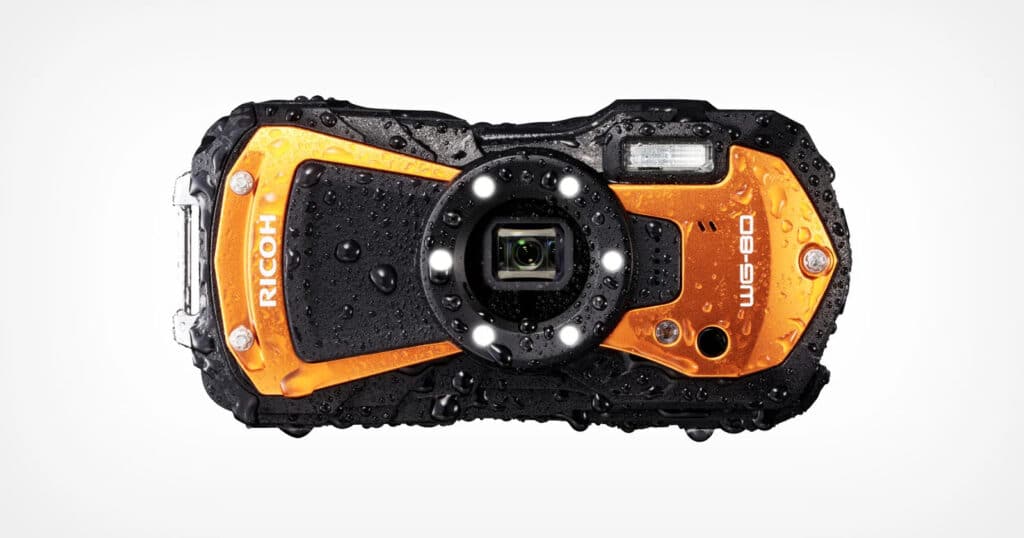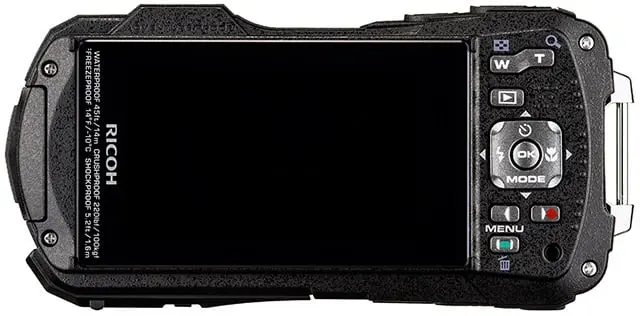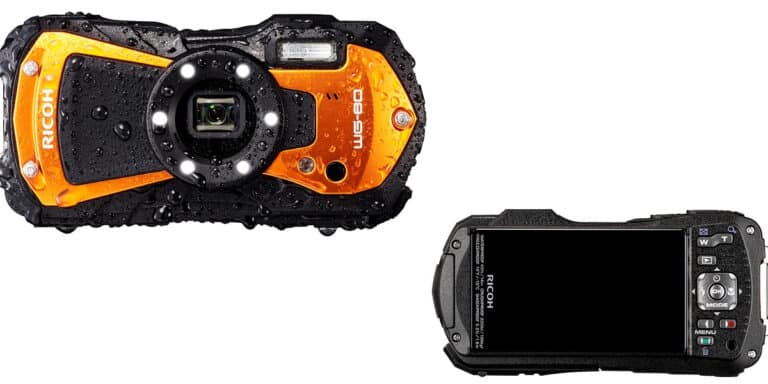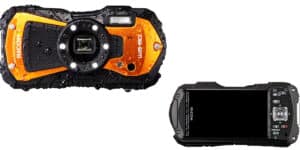The Ricoh WG-80 rugged camera is an intriguing proposition because it has an adamant design that is incredibly waterproof and crushproof, with optical zoom and macro photography capabilities. There’s also a lot to appreciate about it on paper.
Point-and-shoot cameras in the sub-$100 category are still around today, and models like the Ricoh WG-80 show up more frequently. This category of waterproof cameras provides more protection, superior zoom capabilities, and a few extra functions that are difficult to replicate in mobile devices to stand out from smartphones.
Let’s examine the Ricoh WG-80 rugged camera and decide where its potential is most actually utilized.
What will you see here?
Ricoh WG-80: Strong and Economical

This Ricoh WG-80 rugged camera has a sporty, striking appearance. The solid rubberized body contrasts with the brilliant metallic faceplate, which catches the sunlight. You can choose an all-black version in addition to the striking orange one we tested.
The layout is typical for tiny cameras. The WG-80’s dimensions are 2.4 by 4.8 by 1.2 inches (HWD) and 6.8 ounces, making it simple to hold and fit into most pockets. When users turn the camera on or zoom in, its internal zoom lens rotates, so the camera’s footprint doesn’t change.
The WG-80 was dropped & submerged in the sink for testing. The camera can operate at temperatures as low as 14 degrees Fahrenheit, at depths of up to 46 feet, under the pressure of up to 220 lb-ft, and it can endure drops from heights of up to 5.2 feet. But it could not use for underwater imagery.
Wide-angle action cameras
The WG-80 differs from smartphones and wide-angle action cameras thanks to its zoom lens. It has a 5x zoom range (28-140mm) with a near focus for macro photography. Six LED lights surround the lens to assist in illuminating up-close objects that are under the shadow. Additionally, a xenon flash is provided for stock photos.
The lens has a small F3.5-5.5 f-stop. It falls short of the F2.0-4.9 zoom of the Olympus TG-6 and lags well behind a top smartphone with such a night shot feature for low-light conditions. However, the lights on the WG-80 are still enough for illuminating shaded regions throughout a home inspection or even for contract work. We are therefore glad to discover a variety of flash options.
Unfortunately, the macro lights are not powerful enough to make a difference on sunny days. The macro lights won’t be of any assistance if you’re hoping to use them to compensate for any shadow the camera could have thrown on your subject in the otherwise bright scene. The Olympus TG-6 or its $50 FD-1 ring-light add-on produces superior results for that kind of work.
Is it Build Quality good?

The Ricoh WG-80 rugged camera is 1.2 inches thick at its thickest point, 4.8 inches wide, and 2.4 inches tall. Due to its little bulk, the size & weight combination does give off an air of toughness. With the battery & SD card installed, it measures 6.8 ounces (195 grams) on the scale.
With a metal plate crossing the front face, the exterior is primarily constructed of textured plastic that feels pleasant in the hands and should add to its longevity. The grip and slickness of the camera don’t seem to change when it’s wet.
The WG-80 has undergone tests to determine its waterproofness up to 45 feet (14 meters), crushproofness against weights up to 220 pounds (100 kilograms), and freezeproofness at temperatures as low as 14 degrees Fahrenheit, and shockproofness at heights of up to 5.2 feet (1.6 meters). Several statistics about the camera’s ruggedness are printed directly on the back of the device. It is safe to conclude that this camera can withstand accidents better than most conventional camera bodies and can continue to be used in more situations, such as underwater, without needing specific attachments.
The 28-140mm, f/3.5-5.5 optical zoom lens on the Ricoh WG-80, does not extend past the front protective element; instead, it simply moves when enclosed behind it. The fact there were no moving parts from the outside besides the buttons contributes to its durability. Six screws or a plastic panel appear to hold the front element in place, but Ricoh does not appear to supply replacement glass directly to customers in a way that makes it simple to repair. But surprised by this; it assumed that one could purchase for a reasonable price in the event of damage, similar to how GoPro handles it.
LCD Screen

Since the camera does not have a built-in viewfinder for monitoring, the LCD screen must perform well. Unfortunately, the camera’s strengths do not include this display. Its 2.7-inch size feels constricting, and to make matters worse, it only has 230,000 dots of resolution, making everything appear pixelated and making it impossible to determine whether a subject is in focus until the photos and video have been recorded.
The screen has an anti-reflection coating, which is at least somewhat useful for viewing in bright light, but it won’t completely solve the issue the way a brighter screen might. There is an “Outdoor View Setting” mode in menu options, but it is not useful in sunny weather. The options for this model are -2, -1, Off, +1, & +2.
When it’s dark outside, and you don’t want your screen to be completely blinding, using -2 and -1 is a good idea. Compared to Off, the default, +1 and +2, do not affect the actual screen brightness. This does not increase the real luminance of the screen; all it does is make the apparent exposure lighter, and the contrast on the screen lessened. Simply put, monitoring in bright weather is worse than turning it off.
Quality of Image

The camera has a 1/2.3-inch backside-illuminated Cmos image sensor with a resolution of 16 megapixels. It uses the fact that an iPhone 13 has 12 megapixels but uses a slightly bigger 1/1.9-inch backside-illuminated sensor because this is a point-and-shoot camera as a point of comparison. The WG-80 has an ISO range of 125 to 6,400 and exclusively shoots JPEG images.
The 5x optical zoom lens has 11 parts in 9 groups; 5 are aspherical and have a 28-140mm comparable focal length. Although the lens cannot be manually selected, the wide-angle and telephoto aperture ranges are f/3.5 to f/4.2 and f/5.5 to f/6.6, respectively. Considering that everything is moving internally, this is a flexible zoom range. Depending on their chosen focal length, it can take various pictures with varying feelings.
Downside
The outcomes are not pleasing if you consider the picture quality. The biggest issue is an apparent lack of clarity, but many details are lost at any ISO. You don’t think anyone would be particularly pleased with the smeariness in people’s faces or appreciate stunning landscapes & vacation photos that are reduced to color and contrast. Because the detail is simply not resolved in the way users anticipate in 2022. This is true even for someone who is looking to capture times in life, not necessarily fantastic photography.
Given that this camera costs $330. However, there is an expectation that a standalone camera should, at the very least, be as excellent in a world where so many people have decent cameras on their smartphones. It doesn’t think that’s the case here regarding image quality. Yes, this will have more incredible zoom & better handling, but it’s not entirely in love with the results.
Many of the photo settings on the WG-80 return to default after the camera is switched off and on again can aggravate. These include the ISO, Auto ISO, White Balance, and EV ranges. Conveniently, you can manually adjust the ISO sensitivity or the exposure value (EV) in Program mode, which ranges from -2 to +2. This may have prevented confusion with first-time camera customers who experiment and set the camera one way and wonder why their images have poor exposure and a blue tint days later.
Ricoh WG-80: Macro & Digital Microscope modes
The WG-80’s incredibly close focusing range in Macro & Digital Microscope modes is one of its advantages. It allows optical zooming up to 1.8x and can focus as close as one centimeter in digital microscope mode. A “macro support,” a plastic ring that fastens to the end of a lens, is there with the WG-80’s package. Place the cameras on a level surface to capture steady, extreme close-ups and aim the lens downward.
If it weren’t for its camera containing six built-in LEDs around the end of the lens to highlight close objects, you would be correct in thinking that there wouldn’t be any light coming through, and it would be impossible to photograph like this. The light output can also adjust with five different intensities via a menu option, but according to Ricoh, it is now twice as bright as its predecessor. Oddly, They can adjust the intensity in conventional macro photography but not in digital microscope mode.
If you weren’t explicitly searching for the incredibly subtle variation in the shadows. According to the tests, the macro light isn’t nearly bright enough to significantly influence when there is already moderate lighting. Even on a warm day in the shade, but wouldn’t see any difference between the macro light on & off. The difference is significantly more noticeable for macro subjects indoors; examples were taken with, without, and with a standard flash are shown below.
Interfaces and Controls

Photographers seeking manual settings should go elsewhere because the WG-80 is designed for automatic operation. The capture modes are designed around scene profiles. You can choose from various alternatives for photographs of fireworks, landscapes, macros, underwater scenes, and more.
A Program mode allows you some exposure control using the EV compensation function and a fully automatic option. The latter’s picture can easily brighten or darken using a plus/minus adjustment. The EV function is default hidden in a menu. But you may set the green button to open an on-screen menu for faster access. It gives the controls more adaptability because you can assign up to four functions.
The buttons
The buttons address the essentials in addition. Up top are the power and shutter releases. On the back are the buttons for the self-timer, flash, macro focus, & mode, in addition to the W/T zoom rocker. The controls are complete with menu, playback, delete, & video buttons. On-screen menus are logical and easy to use. For instance, pressing the flash button lets you switch between the macro lights. It makes the camera’s flash automatic, always fire, and never fire.
You only have the 2.7-inch rear display, which is a reasonably poor viewfinder. Though it is bright enough for most outdoor situations, direct sunlight can cause glare when you try to see the screen from an unnatural angle, and the color integrity and contrast drop precipitously.
A lowly 230k dots resolution is significantly less than a high-quality camera’s expected. Despite the glare problems, brightness is pretty good. The sunny day setting offered by Ricoh increases the exposure of your sample. But keeps the screen brightness at its default level.
Power and Connectivity
The Ricoh WG-80 rugged camera has few physical connections because it is a waterproof camera. A locking side door protects the micro USB and micro HDMI connections. While the battery while UHS-I SDXC memory card slots are located on the bottom.
The D-rechargeable L192’s battery should last for roughly 300 pictures. You intermittently used the camera over a few weeks without completely draining the battery, which is a positive indicator. Additionally, it allows USB on-the-go charging. However, they were dismayed to learn that USB-C is used instead of the outdated micro USB type.
The WG-80 oddly lacks any form of wireless connectivity. It’s a puzzling decision considering that on-the-go image uploading through Bluetooth and Wi-Fi has long been a need for cameras.
Conclusion
The $329.95 portable Ricoh WG-80 rugged camera is designed to survive rough handling and can function underwater at levels of up to 46 feet. Although it is far more robust than a smartphone, the camera is tough to recommend for adventure photographers due to its average image quality, outmoded 1080p video, or display with poor picture quality. The GoPro Hero10 Black ($399.99) is the top choice, though. The tough Olympus Tough TG-6 ($499.99) retains our Editors’ Choice award for photos.
















